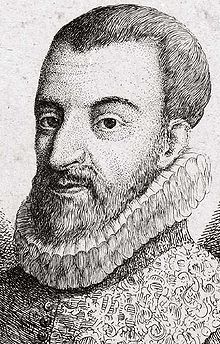
Aegidius Tschudi
Encyclopedia

Tschudi
Tschudi is a surname common in the Canton of Glarus, Switzerland.-History:The Tschudi name can be traced back to 870...
family, of Glarus
Glarus
Glarus is the capital of the Canton of Glarus in Switzerland. Glarus municipality since 1 January 2011 incorporates the former municipalities of Ennenda, Netstal and Riedern....
, Switzerland
Switzerland
Switzerland name of one of the Swiss cantons. ; ; ; or ), in its full name the Swiss Confederation , is a federal republic consisting of 26 cantons, with Bern as the seat of the federal authorities. The country is situated in Western Europe,Or Central Europe depending on the definition....
.
Having served his native land in various offices, in 1558 he became the chief magistrate or Landarnmann, and in 1559 was ennobled by the Emperor Ferdinand
Ferdinand I, Holy Roman Emperor
Ferdinand I was Holy Roman Emperor from 1558 and king of Bohemia and Hungary from 1526 until his death. Before his accession, he ruled the Austrian hereditary lands of the Habsburgs in the name of his elder brother, Charles V, Holy Roman Emperor.The key events during his reign were the contest...
, to whom he had been sent as ambassador.
Originally inclined to moderation, he became later in life more and more devoted to the cause of the Counter-Reformation
Counter-Reformation
The Counter-Reformation was the period of Catholic revival beginning with the Council of Trent and ending at the close of the Thirty Years' War, 1648 as a response to the Protestant Reformation.The Counter-Reformation was a comprehensive effort, composed of four major elements:#Ecclesiastical or...
. It is, however, as the historian of the Swiss Confederation that he is best known. He collected material for three major works, which have never wholly lost their value, though his researches have been largely corrected. In 1538 his book on Rhaetia, written in 1528, was published in Latin and in German--De prisca ac vera Alpina Rhætia, or Die uralt warhafftig Alpisch Rhætia.
Down to the latter part of the 19th century Swiss historical writers had largely based their works on his investigations and manuscripts. The historical reputation of Tschudi has suffered after later research. His statements and documents relating to Roman
Ancient Rome
Ancient Rome was a thriving civilization that grew on the Italian Peninsula as early as the 8th century BC. Located along the Mediterranean Sea and centered on the city of Rome, it expanded to one of the largest empires in the ancient world....
times and the early history of Glarus and his own family had long roused suspicion. Detailed examination has proved that he not merely claimed to have copied Roman inscriptions that had never existed, and amended others in an arbitrary fashion, but that he deliberately forged documents to push back the origin of his family to the 10th century. He thus also entirely misrepresented the early history of Glarus, which is that of a democratic community, and not (as he pretended) that of a preserve of several aristocratic families. Tschudi's historical credit is thus low, and no document printed or historical statement made by him can be accepted without careful verification and examination.
For a summary of these discoveries see Georg von Wyss in the Jahrbuch of the Historical Society of Glarus (1895), vol. xxx., in No. i (1894), of the Anzeiger f. schweizerische Geschichte, and in his Geschichte d. Historiographie in d. Schweiz (1895), pp. 196, 201, 202. The original articles by Vogelin (Roman inscriptions) appeared in vols xi., xiv. and xv. (1886-1890) of the Jahrbuch f. schweizer Geschichte, and that by Schulte (Glarus) in vol. xviii. (1893) of the same periodical. For the defence, see a weak pamphlet, Schulte u. Tschudi (Coire, 1898), by P. C. von Planta.
Tschudi's chief works were not published until long after his death. The Beschreibung Galliae Comatae appeared under Gallati's editorship in 1758, and is mainly devoted to a topographical, historical and antiquarian description of ancient Helvetia
Helvetia
Helvetia is the female national personification of Switzerland, officially Confœderatio Helvetica, the "Helvetic Confederation".The allegory is typically pictured in a flowing gown, with a spear and a shield emblazoned with the Swiss flag, and commonly with braided hair, commonly with a wreath as...
and Rhaetia, the latter part being his early work on Rhaetia revised and greatly enlarged. This book was designed practically as an introduction to his magnum opus, the Chronicon Helveticum
Chronicon Helveticum
The Chronicon Helveticum is one of the oldest accounts of the early history of the Swiss Confederation.The rough draft of the Chronicon Helveticum was written by the historian Aegidius Tschudi from Glarus in 1550...
, part of which (from 1001 to 1470) was published by J. R. Iselin in two stately folios (1734-1736); the rest consists only of rough materials. There exist two rather antiquated biographies of Tschudi by I. Fuchs (2 vols, St Gall, 1805) and C. Vogel (Zürich, 1856), but his extensive complete correspondence has not yet been printed.

